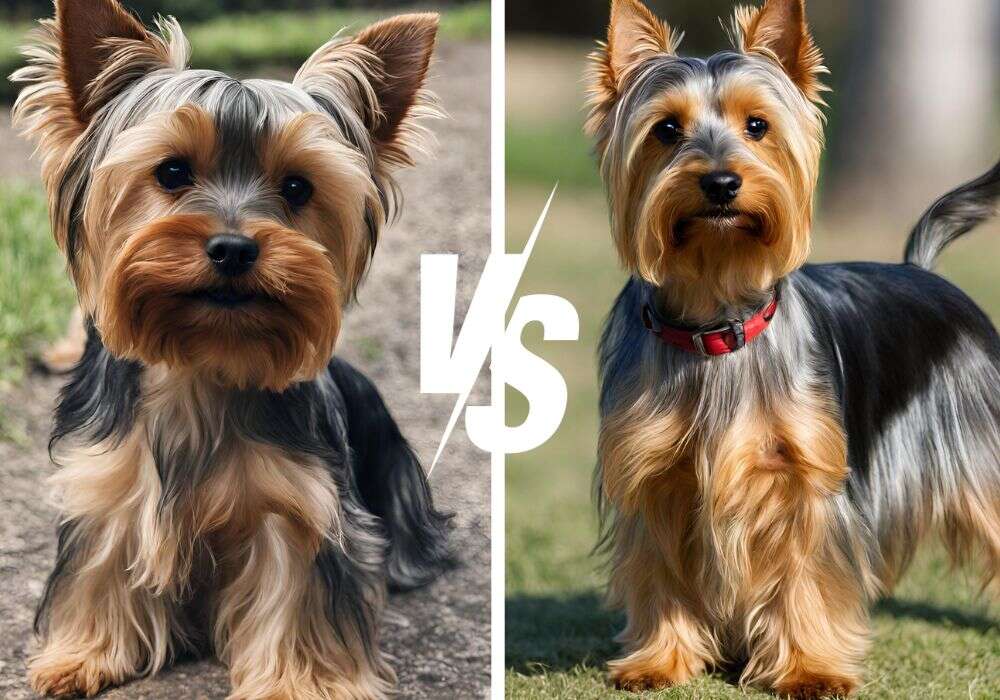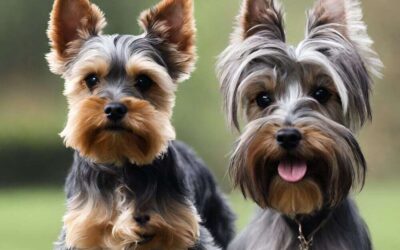Introduction
The Yorkshire Terrier and the Silky Terrier are two popular breeds of toy terriers. They are both small, affectionate dogs with long, silky coats. However, there are some key differences between the two breeds. In this article, we will compare the Yorkshire Terrier and the Silky Terrier in terms of their history, appearance, temperament, grooming, and care. We will also discuss which breed might be a better fit for you based on your lifestyle and preferences.
Breed Comparison Table
| Aspects | Yorkie (Yorkshire Terrier) | Silky Terrier |
|---|---|---|
| Size | ||
| Temperament | ||
| Coat Length | ||
| Lifespan | ||
| Exercise Needs | ||
| Grooming Needs | ||
| Origin |
History of the Yorkshire Terrier
The Yorkshire Terrier originated in Yorkshire, England, in the 19th century. They were originally bred as ratcatchers, and their small size and fearless temperament made them well-suited for the job.
In the early 20th century, the Yorkshire Terrier was introduced to the United States, where it quickly became a popular breed. Today, the Yorkshire Terrier is one of the most popular dog breeds in the world.
The Yorkshire Terrier is a small, sturdy dog with a long, silky coat. They are typically black and tan in color, with a white chest and feet.
Yorkshire Terriers are intelligent and affectionate dogs. They are also very active and playful, and they make great companions for people of all ages.
However, Yorkshire Terriers can also be a bit feisty and stubborn, so they need to be trained and socialized early on.
Overall, the Yorkshire Terrier is a loyal, loving, and playful dog that makes a great addition to any family.
History of the Silky Terrier
The Silky Terrier originated in Australia in the late 19th century. They were developed by crossing Yorkshire Terriers with Australian Terriers and other breeds. Silky Terriers were originally used as working dogs, but they are now popular as companion animals.
The Silky Terrier was recognized by the American Kennel Club in 1959. They are classified as a Toy breed and are known for their silky coat, friendly personality, and small size.
Silky Terriers are typically between 9 and 10 inches tall and weigh between 7 and 10 pounds. They have a long, silky coat that comes in a variety of colors, including black, blue, brown, and cream. Silky Terriers are low-maintenance dogs and only require brushing once or twice a week.
Silky Terriers are known for being friendly, affectionate, and playful. They are good with children and other animals and make great companions for people of all ages. Silky Terriers are also intelligent and easy to train.
Physical Characteristics of the Yorkshire Terrier
Size: The Yorkshire Terrier is a small dog, with a height of 8-10 inches and a weight of 4-7 pounds.
Coat: The Yorkshire Terrier has a long, silky coat that is typically black and tan.
Head: The Yorkshire Terrier has a small, round head with a long, pointed muzzle.
Eyes: The Yorkshire Terrier has dark, almond-shaped eyes.
Ears: The Yorkshire Terrier has small, V-shaped ears that are set high on the head.
Tail: The Yorkshire Terrier has a long, bushy tail that is carried high.
Physical Characteristics of the Silky Terrier
The Silky Terrier is a small, delicate dog with a long, silky coat. They are typically between 10 and 13 inches tall and weigh between 8 and 10 pounds. Their coats are usually black, brown, or cream, and they may have white markings on their chest, feet, or muzzle.
Silky Terriers are known for their gentle, affectionate nature. They are playful and loyal companions, and they get along well with other dogs and children. They are also relatively easy to train, and they make good watchdogs.
However, Silky Terriers can be a bit yappy, and they may bark at strangers or other animals. They also need a moderate amount of exercise, and they should be brushed regularly to keep their coats looking their best.
Overall, the Silky Terrier is a great choice for people looking for a small, affectionate companion. They are easy to train and care for, and they make great pets for families with children.
Temperament of the Yorkshire Terrier
Yorkshire Terriers are known for being feisty, intelligent, and loyal companions. They are also very active and playful, and they love to be around people. However, they can also be a bit yappy and territorial, so it is important to socialize them early and train them to behave properly.
Key Points:
- Yorkshire Terriers are feisty, intelligent, and loyal companions.
- They are also very active and playful.
- They can be a bit yappy and territorial, so it is important to socialize them early and train them to behave properly.
Temperament of the Silky Terrier
The Silky Terrier is a gentle, affectionate, and playful breed. They are known for being good with children and other pets. They are also intelligent and easy to train.
Key Points:
- The Silky Terrier is a gentle, affectionate, and playful breed.
- They are known for being good with children and other pets.
- They are intelligent and easy to train.
Training of the Yorkshire Terrier
Yorkshire Terriers are intelligent and eager to please, making them relatively easy to train. However, they can also be stubborn and independent, so it is important to be patient and consistent with your training methods.
Positive reinforcement is the most effective way to train a Yorkshire Terrier. This means rewarding them with treats, praise, or petting when they perform a desired behavior. Avoid using harsh punishment, as this can damage your relationship with your dog and make them less likely to cooperate.
Yorkshire Terriers are quick learners, so they can typically master basic commands in a few weeks. However, it is important to continue training them throughout their lives in order to keep them well-behaved.
Some of the basic commands that you can teach your Yorkshire Terrier include:
- Sit
- Stay
- Come
- Down
- Heel
You can also teach your Yorkshire Terrier more advanced commands, such as shake, roll over, and play dead.
Socialization is also an important part of training a Yorkshire Terrier. This means exposing them to new people, places, and animals in a positive way. This will help them to become well-rounded dogs who are comfortable in different situations.
By following these tips, you can train your Yorkshire Terrier to be a well-behaved and obedient member of your family.
Training of the Silky Terrier
Silky Terriers are intelligent and eager to please, which makes them relatively easy to train. However, they can also be stubborn and independent, so it is important to be patient and consistent with your training methods.
Here are some tips for training your Silky Terrier:
- Start training early. The best time to start training your Silky Terrier is when they are young, as they are more receptive to learning new things at this stage.
- Use positive reinforcement. Silky Terriers respond well to positive reinforcement, such as treats, praise, and petting.
- Be consistent with your training methods. It is important to use the same training methods consistently in order for your Silky Terrier to learn what is expected of them.
- Be patient. Silky Terriers can be stubborn and independent, so it is important to be patient with them during training.
With patience and consistency, you can train your Silky Terrier to be a well-behaved and obedient member of your family.
Final Thoughts</h2?
When comparing Yorkies to Silky Terriers, it’s important to recognize their individual grooming and health care needs. For Yorkies, appropriate yorkie feeding guides can be crucial, while Silkies might have different dietary requirements. Also, understanding common Yorkie health problems is essential for their care. Further, considering the yorkie puppy supplies needed for young Yorkies is a vital part of puppy care.
FAQs about Yorkie and Silky Terrier
1. Which breed is more suitable for families with kids?
Both the Yorkie and Silky Terrier can be great family dogs. However, due to their small size, it’s essential to supervise interactions between these breeds and young children. Silky Terriers are often slightly more tolerant of kids, but it varies from dog to dog.
2. Do these breeds require professional grooming?
Yes, both breeds have long, silky coats that benefit from professional grooming. Regular brushing at home and periodic trips to the groomer will keep their hair mat-free and looking its best.
3. Are Yorkies and Silky Terriers hypoallergenic?
While no dog is entirely hypoallergenic, both breeds are often recommended for allergy sufferers due to their hair-like coats. Regular grooming can further reduce the amount of dander and hair in the environment.
4. What health issues are commonly associated with these breeds?
Both breeds may face dental issues, patellar luxation, and eye conditions. Regular vet check-ups and good dental hygiene practices can help address some of these concerns.
5. Which breed is more trainable?
Both breeds are intelligent, but Silky Terriers are often considered slightly easier to train due to their eager-to-please nature. However, with consistent training and positive reinforcement, both breeds can be well-mannered companions.

As a lifelong dog lover, I fell in love with Yorkies for their spunky personalities, intelligence, and unwavering loyalty.
As a dedicated Yorkie owner, I have spent years learning about the breed and how to provide the best possible care for them. From finding the proper diet to exercise, and so much more! I take every aspect of my Yorkie’s life seriously.
In addition to being a loving dog parent, I’m an avid blogger, sharing my experiences and insights on all things Yorkie-related. From training tips to grooming advice, Yorkieclothing.com is a go-to resource for other Yorkie owners worldwide.




